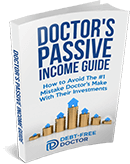I Followed Dave Ramsey for 7 Years—Here’s Why I Switched
Do you ever wonder if the financial advice you’re following is actually setting you free, or just keeping you busy?
After dental school, I had over $300,000 in student loans, zero investing knowledge, and big financial goals. So, like many, I turned to Dave Ramsey’s Baby Steps. His voice was everywhere—on the radio, in books, even trending on TikTok.
His message? Simple and strong: Live below your means. Get out of debt. Stay out. Save for retirement. It worked for a while—until I realized I had followed a debt-free journey that didn’t actually lead to financial independence.
► Prefer to watch instead of read? Check out my full story here:
Don’t Miss Any Updates. Each week I’ll send you advice on how to reach financial independence with passive income from real estate.
Sign up for my newsletterMy Financial Journey: From Debt to a Dead End
I followed the debt snowball method, knocking out the smallest debts first to build momentum. I attacked my student loans with focus and discipline. Every extra dollar went to monthly payments, even when I could have gotten better rates by refinancing.
Eventually, I paid off my student loans, car loan, and even my first house. I had no consumer debt. According to Ramsey, I was winning. But something was missing.
Related: A Dentist’s Take on Dave Ramsey’s Baby Steps
The Missing Piece
I was maxing out my retirement savings, contributing to tax-advantaged accounts like a 401(k) and eventually a Roth IRA. But all that money was locked away. It felt like I was throwing my best earning years into a vault I couldn’t touch until 60.
At the same time, I kept hearing success stories on personal finance podcasts. People were creating financial freedom much earlier than retirement age. Many of them were building income through rental properties, real estate, or side businesses. I had a good income, but no income that didn’t rely on me working with my hands.
Then came the wake-up call.
The Accident That Changed Everything
While skiing with my family, I injured my hand. As a periodontist, my hands are my livelihood. That injury could have ended my career.
That’s when I realized I had followed a system that created financial security but not financial flexibility.
I had built a retirement plan, but not a freedom plan. I had no passive income. And everything I was working for was still decades away.
The Major Differences That Shifted My Mindset
The opportunity cost of sticking to Ramsey’s path became clear: I was locking away every dollar and leaving myself with no income today.
Meanwhile, others were using home equity lines of credit (not that I recommend this), investing in real estate syndications, and finding different ways to build wealth that actually showed up in their bank accounts each month.
Even though I had a solid financial house, it wasn’t built to last if I couldn’t work.
Why Ramsey’s Approach Doesn’t Fit Every Household
Ramsey’s plan is designed for people with low financial literacy and out-of-control spending (the typical American). If your financial life includes high-interest credit cards, no savings, and zero income left at the end of the day, Ramsey gives you discipline and structure.
But if your household income is high and your money habits are already strong, there are better ways.
The 15-year mortgage might not be better than the 30. Paying off a car loan at 3% instead of investing those dollars might not make sense.
And skipping real estate because it involves debt ignores the tax benefits, appreciation, and passive income opportunities.
Join the Passive Investors CircleWhat I Do Now: The WOW Steps
| WOW Step | Title | Key Concept |
|---|---|---|
| 1 | Get Financially Clear | Track income & expenses to gain control—clarity is the foundation of financial freedom. |
| 2 | Build Your Emergency Buffer | Save 3–6 months of expenses in a high-yield savings account to create a safety net. |
| 3 | Eliminate Toxic Debt | Use the debt snowball or avalanche method to wipe out high-interest debt and free up cash. |
| 4 | Know Your Freedom Number | Calculate your monthly expenses × 1.1 to find the passive income needed to make work optional. |
| 5 | Build Your Passive Income Snowball | Invest in real estate, dividend ETFs, or cash-flowing businesses to slowly replace active income. |
| 6 | Make Work Optional | Once income meets your Freedom Number, choose work on your terms—not because you have to. |
| 7 | Leave a Legacy | Use trusts, tax planning, and financial education to preserve and pass on wealth for future generations. |
Living the Rich Life Now—Not Someday
Too many high earners are living paycheck to paycheck with lots of money tied up in savings or retirement. But their financial stress remains high because there’s no freedom, no flexibility, and no plan for the present.
We don’t talk enough about the cost of deferring life until it’s almost over.
Sometimes, that looks like grinding through work while your kids grow up.
Sometimes, it’s not being able to take a break when you’re burned out.
Final Thoughts
If you’re a doctor, dentist, or high-income earner who’s followed Ramsey’s plan and still feels stuck, you’re not alone. Ramsey helped you build discipline. But now it’s time to build wealth.
Let go of the one-size-fits-all advice. Lean into strategies that work for your current situation. Surround yourself with people who think bigger. Use every tool available—including tax advantages, smart leverage, and passive income—to create a plan that actually gets you to early retirement, or work-optional status, much faster.
The WOW Steps aren’t about living recklessly. They’re about choosing a path that rewards you today and tomorrow.
Join the Passive Investors Circle


